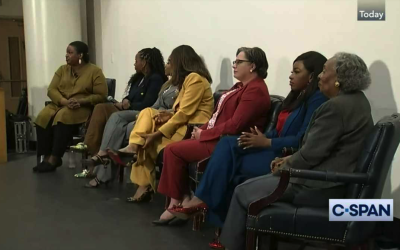By Catie Edmondson, March 15, 2019
In Most Diverse House, Aides of Color Join the Ranks of ‘Firsts’
WASHINGTON — A day after House Democrats retook the majority, Speaker Nancy Pelosi sent a message to her colleagues that would soon be adopted as a creed.
“We know that the diversity in our ranks is a strength,” Ms. Pelosi wrote, “and a reflection of the American people that it is our great honor to serve.”
She was imploring them to adopt the National Football League’s practice of interviewing a minority candidate for senior positions. Her letter was an acknowledgment of a long-held truism on Capitol Hill — while Congress has long been remarkably racially homogeneous, perhaps nowhere has that been more apparent than among the ranks of Capitol Hill staff, regardless of party. Despite an increasingly diverse House, the staff employed by those members are not only less ethnically diverse than the country, but less diverse than the members who employed them.
That is changing. In the most racially diverse House in history, a record number of top Democratic aides are men and women of color, including the speaker’s national security adviser and the majority whip’s chief of staff.
In September, 13.7 percent of top aides in the House were minorities, according to research by the Joint Center for Political and Economic Studies, a Washington-based research center. Bolstered by hires made by new members of Congress on both sides of the aisle, that number has risen to 20.9 percent, the center said — by no means transformative but a noticeable shift in halls of power that have always been disproportionately white.
When Representative Hakeem Jeffries of New York, the No. 5 Democrat, announced his roster of lieutenants last week, six of eight were people of color, four of them women, including his chief of staff.
“The diversity of experience and background of our new senior team reflects the gorgeous mosaic of the Democratic Caucus,” Mr. Jeffries, who is black, said in a statement.
As House Democrats pursue an aggressive agenda, holding high-profile oversight hearings and passing legislation on health care, campaign finance transparency, and gun control, these aides are influencing major policy decisions, shaping messages and leading the staffs of nearly half a dozen committees, including the powerful Ways and Means and Appropriations panels.
“It is a best business practice,” Kemba Hendrix, director of the House’s diversity initiative, said in an interview. “If we’re looking to create policy that impacts people from different frameworks, we have to be able to do that” with aides with diverse backgrounds.
Spencer Overton, president of the Joint Center for Political and Economic Studies, said the prominence of minority aides is as important as the quantity.
“This change in focus in terms of leadership is important,” he said.
“We need diversity in big tech, on corporate boards. With Congress, however, the primary function is to represent people,” Mr. Overton continued. “So the failure of members of Congress to hire diverse staff and diverse top staff really goes to their dysfunction as an institution.”
The diversity expansion did not happen on its own. Representative Jim McGovern of Massachusetts, who is white and is chairman of the House Rules Committee, expanded a diversity initiative established last Congress by the Democratic Caucus to the entire House as part of a rules package approved when the Democrats took control.
Ms. Pelosi, who is white, hired Ms. Hendrix to lead the House Democratic Diversity Initiative when she was House minority leader last Congress. Now that Democrats are in the majority, Ms. Hendrix assists all House offices with improving their hiring practices and creating a pipeline of diverse aides. In addition to fielding questions and conducting one-on-one sessions with offices, she oversees a resume bank curated in collaboration with the Democratic Caucus that helps pull in candidates from traditionally neglected networks, such as historically black colleges.
“This is a place where who you know does, at times, affect how you are able to access employment,” Ms. Hendrix said. “The ability to access networks and become familiar within those networks takes time.”
Wyndee Parker, Ms. Pelosi’s African-American national security adviser, recalled, “when the speaker was first elected in early 2007, I started looking around and recognizing that I was seeing more women and more minorities in key roles.”
“There has been some improvement since that time, and I’m happy about that,” she added, “but I think that we still have a ways to go.”
For one thing, the Republicans have not kept the same pace. In their leadership offices, there are far fewer minorities. Representative Kevin McCarthy of California, who is white and is the Republican leader, employs an Asian-American deputy chief of staff, and Representative Gary Palmer of Alabama, who is white and the chairman of the Republican Policy Committee, employs an African-American chief of staff. Neither aide was available to comment.
The implications of having a diverse staff are significant. Top aides have the ear of members. Crucial to establishing a pipeline of diversity, they are also responsible for hiring decisions. Top aides often go on to jobs in the executive branch or run for Congress themselves.
Creating a pipeline is particularly important for young minority professionals, diversity experts say. For years, internships — one of the first opportunities to make connections on the Capitol Hill — were unpaid, thinning the applicant pool by affluence. And the social networks that can make or break getting jobs in congressional offices have long been historically white.
Shuwanza Goff, the first African-American woman to direct action on the House floor, recalled entering rooms full of men, many with more experience than her, and having to tell them “what the plan is.”
“That was challenging for me and something to grapple with,” she said.
Brandon Casey, the first minority staff director of the Ways and Means Committee, acknowledged that there was a stigma against people of color in top staff jobs “because they haven’t done it before.”
As staff director, he is responsible for hiring interns and full-time employees, and he makes a point of challenging his lieutenants to find candidates “outside of the traditional networks.”
“We’re not only showing staffers that they can rise up to the job,” Mr. Casey said, “but showing all members that we can do this job.”



